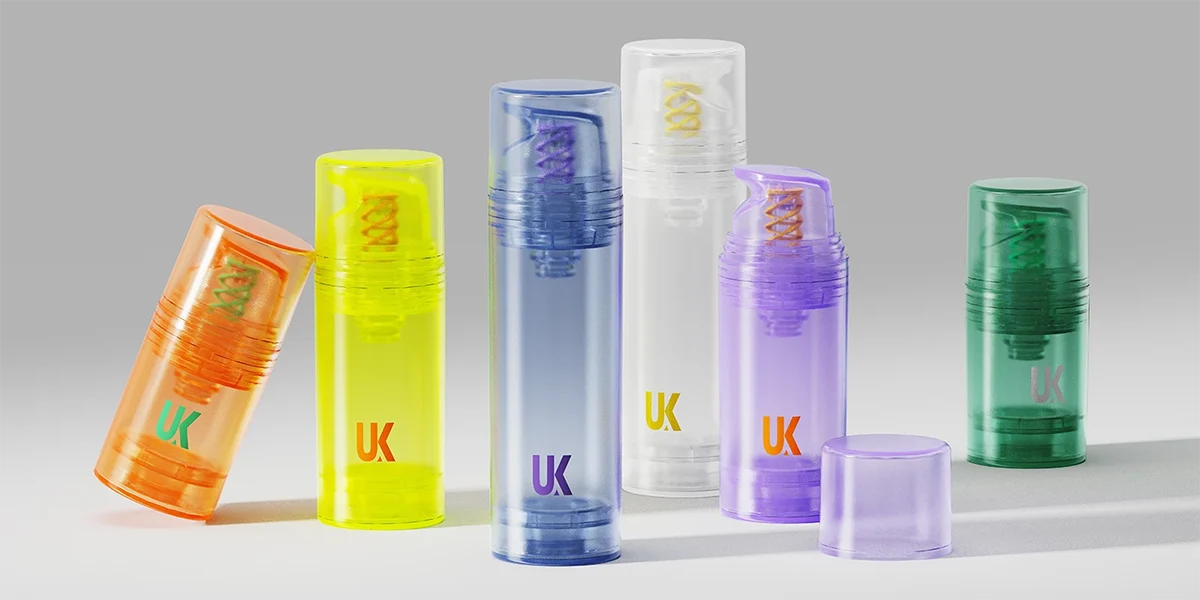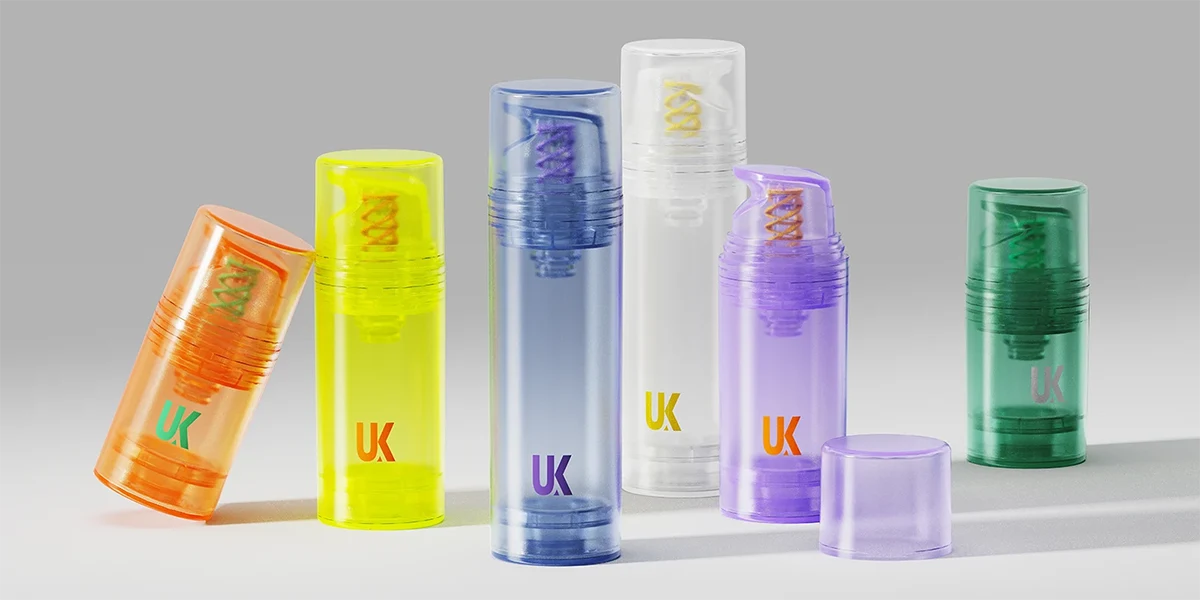What is an Airless Pump Bottle? Everything You Need to Know About It

Founder of UKPACK, Chief Packaging Designer with 18 years of experience, Red Dot Award Winner
Specialize in custom, innovative, and sustainable packaging solutions for cosmetics, skincare, personal care, hair care, food and beverage, and more.

- Vad är en luftlös pumpflaska
- Hur fungerar luftlösa pumpflaskor?
- Viktiga fördelar
- Airless pumpflaskor vs traditionella pumpflaskor
- Toppapplikationer för luftlösa pumpflaskor
- Hur man väljer rätt luftlös pumpflaska
- Underhåll & Felsökning
- Anpassnings- och varumärkesalternativ
- Överväganden om regler och efterlevnad
- Hållbarhet & miljöpåverkan
- Kostnads- och prisfaktorer
- Påfyllningsbara kontra engångssystem
- Industriinnovationer och framtidstrender
- Fallstudier och feedback från användare
- Fyllnings- och monteringsprocesser
- Regional Supply, MOQ & Logistics
- Slutsats
- Vanliga frågor
Airless pump bottles have revolutionized product dispensing by combining precision, hygiene, and sustainability in one sleek package. You might be asking, “Why all the buzz around these fancy dispensers?” Well, they literally keep your formula fresh—and nearly wipe out waste—by using an internal piston instead of a dip tube to deliver every last drop.
Whether you’re a brand owner looking to elevate your skincare line or a consumer tired of half‑empty tubes, this article is your go‑to resource.
What Is an Airless Pump Bottle
Airless pump bottles are non‑pressurized dispensers designed to maintain a vacuum inside the container.
They rely on a piston or diaphragm at the base that moves upward as you press the pump, forcing product through the nozzle without letting air in.
Traditional pumps use a dip tube that leaves residual product and allows air—and contamination—into the bottle. Airless systems eliminate that problem, ensuring both product integrity and user satisfaction.
How Do Airless Pump Bottles Work?
Understanding the vacuum mechanism is simpler than it sounds.
When you press the actuator, the piston lifts, creating negative pressure that draws formula upward and out—no air gaps allowed.
Imagine squeezing a toothpaste tube from the bottom: everything moves out smoothly, and nothing is left behind. That’s the beauty of an airless pump bottle in action—consistent dosing, clean dispensing, and zero oxidation.
Key Advantages
Let’s dive into why you and your customers will love airless pump bottles.
Waste Reduction
Airless bottles deliver almost 100% of their contents, slashing waste compared to jars or tubes.
That means less product lost in the bottom corners—so you get more value and your brand looks more efficient.
Oxidation Protection
Without air exposure, sensitive actives like vitamin C and retinol stay potent longer, extending shelf life by up to 15% in some studies.
Think of it as an oxygen‑free vault for your formula, keeping ingredients stable until you need them.
Reduced Preservatives
By isolating product from contaminants, airless systems allow formulators to cut back on preservatives without sacrificing safety.
Consumers demanding “clean” and “natural” labels will thank you—and your marketing team will thank you even more.
Hygienic Dispensing
No more double‑dipping your finger into a jar—airless pumps ensure touch‑free delivery, reducing microbial contamination risks.
It’s like having a sterile lab environment at your fingertips, every time you pump.
360-Degree Functionality
Unlike traditional pumps that struggle upside down, airless pump bottles work at any angle. Whether you’re traveling or applying makeup in a rush, you can count on consistent performance.
It’s like having a bottle that’s always ready to perform, no matter the situation.
Eco‑Friendly Design
Many airless pumps are mono‑material (PP or PET), eliminating metal springs and easing recyclability.
Some models incorporate up to 52% PCR content, showing true circular‑economy commitment.
Airless Pump Bottles vs Traditional Pump Bottles
Still wondering how airless pump bottles stack up against their traditional counterparts? Let’s break it down with a side-by-side comparison:
| Feature | Airless Pump Bottle | Traditional Pump Bottle |
|---|---|---|
| Dispensing Mechanism | Piston/diaphragm pushes from bottom | Dip tube draw-through, replaces volume with air |
| Air Exposure | Zero air ingress | Air enters as product is dispensed |
| Product Waste | Nearly 0% | Often leaves 5–15% residual product |
| Preservatives | Can be greatly reduced | Higher amounts needed to prevent microbial growth |
| Suitability | High‑value and sensitive formulas | Bulk and low‑cost formulations |
| Orientation | Works at any angle | Best upright |
| Cost | Premium packaging cost | Lower unit cost |
From user experience—airless bottles feel like a well‑oiled machine, offering a smooth, consistent output—whereas conventional pumps can sputter or clog as air pockets form inside
Top Applications for Airless Pump Bottles
Where do airless pump bottles shine? Let’s explore.
Skincare & Cosmetics
Ideal for serums, lotions, and creams where ingredient stability is paramount.
Active‑rich formulas—think retinoids, peptides—stay potent, giving consumers visible results.
Pharmaceuticals & Healthcare
Topical gels and medicated formulations benefit from sterile, controlled dosing, crucial for patient safety.
Airless systems support “pharmacy‑grade” packaging in cleanroom fills.
Personal Care
Hand sanitizers, hand creams, and specialty lotions gain extra shelf life and hygiene with airless systems.
Travel & Sample Sizes
Compact 15–50 mL airless bottles won’t leak, can dispense at any angle, and meet TSA requirements.
Imagine a mini, on‑the‑go formula that never clogs—a travel essential.
How to Choose the Right Airless Pump Bottle
Picking the perfect model is a bit like finding the right shoe: fit, function, and style all matter.
Material Selection
- PP vs. PET vs. Glass: PP and PET are lightweight and easily recyclable; glass offers luxury appeal but needs special venting for the piston.
- PCR Options: Look for pumps with post‑consumer recycled content to hit sustainability targets.
Size & Capacity
- Travel (10–30 mL): For samples or on‑the‑go.
- Standard (30–100 mL): Daily skincare or hand creams.
- Large (100–200 mL): Hair products or body lotions.
Pump Head Style
- Fine Mist Sprays: Serums or facial mists.
- Standard Dispensing Pumps: Lotions and creams.
- Custom Tips/Nozzles: For eye creams or spot treatments.
Design & Aesthetics
- Finishes & Coatings: Matte, metallic, UV printing, foil stamping—choose what resonates with your brand story.
- Color & Shape: Custom molds and ergonomic shapes can enhance shelf appeal.
Supplier Credentials
- Certifications: ISO 9001, GMP, or FDA compliance.
- Lead Times & MOQs: Confirm production timelines for launches.
- Sustainability Practices: Recyclable materials or refill programs.
Maintenance & Troubleshooting
Even the best pumps can hiccup—here’s how to keep yours running smoothly.
Cleaning Methods
Rinse the actuator and nozzle with warm water and mild detergent after each batch; use a small brush to clear viscous residue.
For deep cleans, soak parts overnight and air‑dry in a dust‑free area.
Common Issues & Fixes
- Pump Doesn’t Prime: Try tapping the bottle bottom gently or depress the pump multiple times to purge trapped air.
- Sticking Piston: Insert a fine pin or toothpick into the base vent to free the piston then re‑prime.
- Clogged Nozzle: Soak in warm water or a 1:10 vinegar solution to dissolve dried formula.
Preventive Tips
Prime each pump before first use, and instruct end‑users to wipe the nozzle after use to prevent buildup.
Customization & Branding Options
Your packaging can tell a story—here’s how to make it memorable.
Aesthetic Enhancements
- Custom Molds: Unique silhouettes help your product stand out.
- Surface Treatments: Soft‑touch coatings, matte lamination, and metallic accents add a luxe feel.
Refillable Systems
Explore patented inner cartridges or hybrid designs that allow consumers to swap refills, reducing single‑use plastic waste.
Implement incentive programs (e.g., discounts on refills) to boost customer loyalty and sustainability credentials.
Regulatory & Compliance Considerations
Stay on the right side of the law with these key requirements.
FDA & EU Cosmetics Regulations
The FDA’s Cosmetic Act and EU Regulation (EC) No 1223/2009 mandate material safety, leachables testing, and labeling standards for cosmetic packaging.
Ensure plastic components meet 21 CFR § 177.1520 for indirect food contact if cross‑applicable.
Transport & Labeling
Follow IATA UN packaging instructions for flammable or temperature‑sensitive formulations; include proper hazard and lot code labels.
Sustainability & Environmental Impact
Consumers and regulators demand greener solutions—here’s how airless bottles measure up.
Sustainability Certifications
- RecyClass & APR: Validate recyclability for PET and PP mono‑materials.
- ISCC PLUS & Cyclos‑HTP: Certify bio‑content and traceable circular credentials.
Life‑Cycle Assessment (LCA) Insights
Studies show mono‑material airless systems have a lower carbon footprint than multi‑component pumps and jars, thanks to reduced material complexity and extended product lifespan.
A comparative LCA found PET airless containers outperformed glass and aluminum in greenhouse gas emissions, energy use, and water consumption.
Cost & Pricing Factors
Navigating cost structures can be tricky—let’s break it down.
Cost Breakdown
- Raw Materials: Bulk PP and PET prices fluctuate; PCR content carries a slight premium.
- Tooling & Molds: One‑time investment of $5,000–$20,000 depending on complexity.
- Printing & Finishing: Specialty coatings and custom colors add $0.05–$0.20 per unit.
- Freight & Duties: Regional sourcing affects lead time and landed cost.
Minimum Order Quantities (MOQs)
- Large OEM Runs: MOQs of 10,000+ units unlock best per‑unit pricing.
- Small‑Batch Brands: Expect MOQs of 1,000–5,000 with higher unit costs.
Refillable vs. Disposable Systems
Is it time to invite consumers back for more?
Consumer Acceptance
Surveys indicate 60% of eco‑minded consumers are willing to purchase refill packs if hygiene and convenience match single‑use performance.
Refillable models foster brand loyalty but require clear instructions and accessible refill points.
Brand Challenges
Industry Innovations & Future Trends
Peeking over the horizon, here’s what’s next.
Metal‑Free Pumps
Eliminating springs streamlines recycling and reduces contamination risks; UKPACK’s mono plastic airless bottle is a prime example.
Smart Dispensers
Glass + Pouch Hybrids
Lumson’s XTAG pairs a reusable glass shell with a sealed pouch insert, cutting CO₂ emissions by 38% per LCA.
This model blends luxury appeal with sustainability—perfect for premium lines.
Case Studies & User Feedback
Peeking over the horizon, here’s what’s next.
UKPACK’s UKA19 Series Airless Pump Bottle

UKPACK’s mono‑material UKA19 series airless pump bottles (30–200 mL) are made from 99 % PP resin with only essential additives, achieving CTI’s mono‑material compliance for fully curbside‑recyclable packaging.
Fan Beauty Diary adopted the UKA19 series for their lotion and toner ranges, drawn by its combination of elegant aesthetics and vacuum‑driven precision dosing—without any air ingress or residual waste.
Since launch, Fan Beauty has seen overwhelming positive feedback: customers praise the “no‑drip,” “full‑extraction” performance, and there have been zero reported pump failures or clogging incidents in routine use.
Customer Voices
On Reddit, users praise airless serums for “no‑drip” performance and full extraction—comments like “I finally get every last drop!” are common.
Filling & Assembly Processes
Ensuring quality from factory to face.
Sterile & Low‑O₂ Filling
High‑value actives require filling in cleanrooms or nitrogen‑blanketed lines to preserve vacuum integrity.
Automated Production
Rotary and inline fillers with torque‑controlled capping maintain consistency at speeds up to 200 bottles/min.
Regional Supply, MOQ & Logistics
Global sourcing insights to streamline your supply chain.
Production Hubs
- China: Cost‑competitive with MOQs of 5,000+.
- Europe: Quick turn for high‑quality, lower MOQs—ideal for small luxury runs.
- North America: Limited capacity but agile prototyping and on‑demand fills.
Lead Times & Costs
China: 8–12 weeks; Europe: 6–8 weeks; North America: 4–6 weeks. Balance speed vs. cost based on your launch timeline.
In contrast, UKPACK delivers within 3–4 weeks—perfect for brands needing rapid market entry.
Conclusion
Airless pump bottles are more than a packaging trend—they’re a performance, sustainability, and brand‑building powerhouse. By understanding the vacuum mechanism, benefits, customization options, and regulatory landscape, you can select and deploy the ideal system for your products. Don’t just dispense—elevate your brand story and show consumers you’re serious about quality, hygiene, and our planet.
If you’re looking for the perfect airless pump bottle for your next project, don’t hesitate to reach out to UKPACK. With years of expertise and innovation in packaging solutions, UKPACK offers the ultimate airless pump bottle solutions tailored to meet your needs—helping you deliver exceptional products with confidence and style.
FAQs
1. How does an airless pump bottle differ from a regular pump?
Airless pumps use a vacuum piston to dispense all content without air ingress, whereas regular pumps rely on a dip tube and leave residual product.
2. Can I use an airless pump bottle for thick creams and gels?
Yes—most airless systems handle viscosities up to 200,000 cP, and some offer dual‑phase pumps for extremely viscous formulas.
3. Are airless bottles recyclable?
Mono‑material pumps (PP or PET) are widely recyclable; look for RecyClass or APR certifications to confirm.
4. What is the typical shelf life extension with airless packaging?
Airless packaging can extend shelf life by up to 15% through oxidation prevention, according to PCR bottle studies.
5. How should I troubleshoot a non‑priming airless pump?
Tap the base gently, depress the actuator 8–10 times to purge air, or insert a fine pin into the vent hole to free the piston.